TRADITION’s 2022 Book Endorsements – Part II
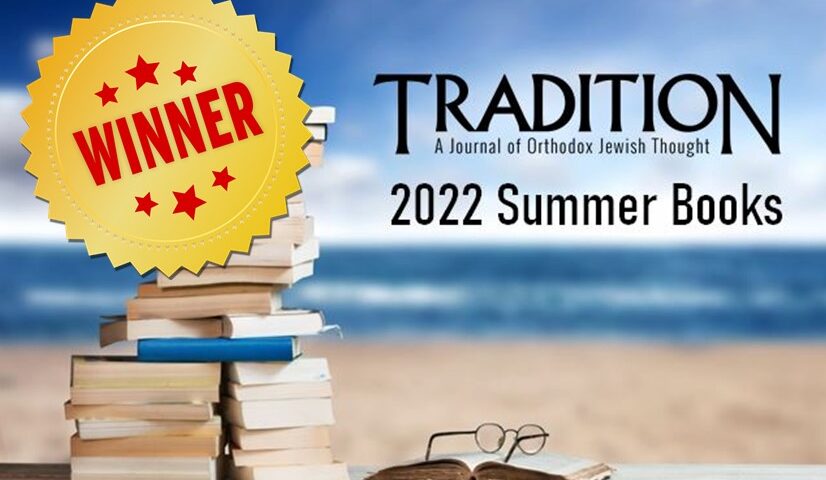
TRADITION concludes this year’s installment of our Editorial Board’s selections for recommended summer reading.
Read the second round of recommendations below (and see Part I here).
Congratulations to Harry Meister of Manhattan for correctly predicting the highest number of books to appear on this year’s list. Enjoy your prize winnings – a subscription to TRADITION (join him!).
Mala Kacenberg, Mala’s Cat: A Memoir of Survival in World War II (Pegasus Books)
Rivkah T. Blau
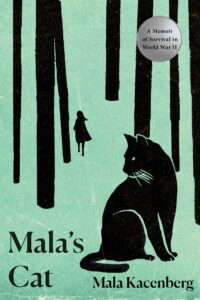 Now we are learning how Jewish women fought back against the Nazis with Intelligence, courage, and daring. Staying alive under harrowing conditions was in itself a victory. Maintaining any form of observance would seem to have been unthinkable. Yet a girl just past bat mitzva determined to keep her religious values while living in the forest for years, and occasionally finding work in a village until the war ended.
Now we are learning how Jewish women fought back against the Nazis with Intelligence, courage, and daring. Staying alive under harrowing conditions was in itself a victory. Maintaining any form of observance would seem to have been unthinkable. Yet a girl just past bat mitzva determined to keep her religious values while living in the forest for years, and occasionally finding work in a village until the war ended.
In 999: The Extraordinary Young Women of the First Official Transport to Auschwitz, Heather Dune Macadam gives an account of a Seder organized by teenaged girls in the concentration camp; in The Light of Days, Judy Batalion details how Jewish women helped weaponize Jewish youth groups to resist the Nazis, and brought food, news, and messages to those imprisoned in ghettos. In Mala’s Cat Mala Kacenberg tells how she stayed in the woods after her sister got a letter to her—don’t come home. Nazis had surrounded their town; Mala might be the only member of the family to survive.
A cat adopted Mala immediately and stayed with her through the ordeal of persuading an elderly woman that she was a young relative who had come to care for her; becoming a farmhand; finding work as a maid far away from home, lest someone recognize her and report her. Being a girl who had attended compulsory public school protected her because she spoke Polish without a Yiddish accent and knew Polish culture and what was popular among Christian girls her age. Blond hair, assumed to be a Polish trait, was an advantage.
There is more to tell, including why she thought her cat’s name should be “Malakh” (Angel), her quick thinking, and her command of languages, the latter a necessity in a land where borders kept changing. She kept kosher throughout her travails until her grandmother appeared in a dream telling her how to handle suspicions that arose when another worker pointed out that she ate only fruits, vegetables, and cheese.
When the war ended the cat disappeared as mysteriously as it had come. Mala went on to a full life in England. She conveys the danger and the cruelty that confronted the Jews, and her resilience and loyalty to her values inspire us readers. An adolescent in her second decade and a man in his eighth decade can both find this a gripping read.
Faye Schulman has left hundreds of photographs showing how Jews resisted; Gerda Weisman Klein wrote a book on her survival and received a Presidential Medal of Freedom in 2011 for her work in education about the Shoah; Michal Aharony wrote about ten women—nine of them Haredi, one non-religious—who helped each other survive three concentration camps and death marches. Roxane van Iperen’s book on two Jewish sisters who ran an oasis for Jews in the Netherlands has just been translated into English and printed as a paperback.
World War I un-prepared Jews for World War II—they thought there would be devastation, but could not imagine annihilation. Today in Ukraine a peaceful population is attacked by a war machine. Ukrainians emigrate. Where could Jews flee?
Carl Bernstein, Chasing History: A Kid in the Newsroom (Holt)
Hillel Goldberg
 “The immediate problem, I gathered, was that I was too short to be copyboy. Or too young, or too young-looking. Not only was I five foot three (and still growing), I was freckled from head to toe. One summer I’d smeared a whole bar of butter over my face because the man who pumped gas at the Tenleytown Amoco station told me — while I filled up my bicycle tires — that butter would make my freckles go away.”
“The immediate problem, I gathered, was that I was too short to be copyboy. Or too young, or too young-looking. Not only was I five foot three (and still growing), I was freckled from head to toe. One summer I’d smeared a whole bar of butter over my face because the man who pumped gas at the Tenleytown Amoco station told me — while I filled up my bicycle tires — that butter would make my freckles go away.”
At the ripe old age of 16, our young butter-smearer interviewed with what was then Washington, DC’s leading newspaper, The Evening Star. When it was disclosed that he hadn’t even graduated from high school, he was turned down cold. Besides, he was calculating the odds of his graduating from high school, “which did not seem good. Even if I was on my best behavior, and assuming I took up studying, graduation was almost a year off.”
Just then, in what would turn out to be a lifetime of catching breaks, a wizened man entered the room. “Meet Mr. Gould Lincoln, the senior editorial writer of the Star.” Our butter-smearing, prospective high school drop-out piped up, informing the senior editorial writer that he, the applicant, was a year older than Gould had been at the start of his newspaper career. The applicant added that he’d taken a journalism class in the tenth grade and published stories.
How many? “I did not mention that I’d been demoted on the paper’s masthead to circulation and exchange manager because of my meager production.” The interviewer promised to read the tenth-grade clippings. The applicant telephoned every two or three days to remind him that he was available. He was hired as a copyboy at $29 dollars a week. Our 16-year-old copyboy skipped out of school long hours each week to work at the Star without anyone at the Star ever questioning him about it.
Our copyboy convinced his boss to let him ride with the night reporter who covered murders and fires. “Though I continued to go to school, I never really cracked a book after that summer, which wasn’t much of a stretch from my regular practice. But now, entering my senior year, I had an excuse not to study: ‘I was a working newspaperman.’” Soon, our copyboy was hoping for, pressing for, a reportorial assignment. Finally he got one. And then another and another. He was good. By the time of John F. Kennedy’s inauguration in January 1961, our copyboy was assigned to supply details from the long parade that would follow the inauguration. An eight-inch snow had blanketed Washington the day before the inauguration and would have prevented our copyboy from reaching D.C. He had to be enterprising in finding a place to sleep and to secure the many notebooks and scores of nickels for the pay phone he would need to call in his findings once every half hour.
Our copyboy has put all this down in his delightful memoir, which contained absolutely nothing of our copyboy’s later eminence. Our copyboy, our memoirist, is named Carl Bernstein of Watergate fame.
Doris Goodwin, The Bully Pulpit: Theodore Roosevelt, William Howard Taft, and the Golden Age of American Journalism (Simon & Schuster)
Shalom Carmy, Editor Emeritus
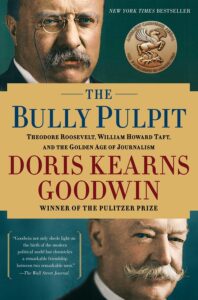 If only as political history, Goodwin’s account of what Richard Hofstadter called “The Age of Reform” would be of current interest because self-styled progressives, descended from the activist, idealistic idea of government associated with Theodore Roosevelt and Woodrow Wilson, are again feeling their oats in the corridors of power. It would join the works of scholars like Ronald Pestritto (America Transformed: The Rise and Legacy of American Progressivism), the lively debate over the administrative state among legal theorists like Phillip Hamburger and Adrian Vermeule, and biographies of Roosevelt and his contemporaries.
If only as political history, Goodwin’s account of what Richard Hofstadter called “The Age of Reform” would be of current interest because self-styled progressives, descended from the activist, idealistic idea of government associated with Theodore Roosevelt and Woodrow Wilson, are again feeling their oats in the corridors of power. It would join the works of scholars like Ronald Pestritto (America Transformed: The Rise and Legacy of American Progressivism), the lively debate over the administrative state among legal theorists like Phillip Hamburger and Adrian Vermeule, and biographies of Roosevelt and his contemporaries.
I recommend Goodwin’s book to a religious audience, not just for its political timeliness, but primarily for its human drama. Once Roosevelt and Taft were two young men making their name in the reformist circles of late 19th century Washington, D.C., walking to work together, full of shared laughter and earnest plans. One became the dynamic president and the other his trusted advisor. The ambitious Roosevelt engineered Taft’s election to the White House, then went off to hunt big game in Africa. Upon his return he became increasingly critical of his successor, eventually challenging him for the Republican nomination in 1912 and later forming the Progressive party, precipitating one of the most personally acrimonious campaigns in American history. The incumbent Taft finished a humiliating third to Wilson and Roosevelt, while TR squandered time and money on a defamation suit against an erstwhile supporter turned Taft partisan. Several years later the ex-presidents had achieved a wary civility. Life went on: Had Roosevelt lived, he might well have returned to the presidency in 1921; Taft later served as Chief Justice. The friendship of a lifetime would not be reconstructed.
Generations ago, when the Progressive agenda was prevalent, and Roosevelt, like his Democrat cousin, was regarded as a model of the imperial presidency, the rift between TR and Taft was usually explained in terms of Roosevelt’s enormous zeal for activist reform and his frustration with Taft’s slower, more conservative pace. Nowadays Roosevelt is not immune to criticism, from the right because of his progressivism, from the left for his failures of political correctness. It is thus increasingly common to attribute the breakdown of relations between the two erstwhile companions to Roosevelt’s bossiness, his compulsion to be the center of attention, “the bridegroom at every wedding and the corpse at every funeral,” as his daughter once put it.
With our greater anxiety about the fragility of family as a reliable source of meaning, among other factors, friendship has become an important ingredient in what many modern people regard as a worthwhile life. The story of TR and Taft is a painful reminder that friendship too is a fragile achievement. The investment of a lifetime can be lost to a fit of cruelty or thoughtlessness or because we lack self-knowledge and sensitivity to our fellows.
When Theodore Roosevelt died, as his mourners stepped back from his wintry grave, one remained standing. William Howard Taft wept uncontrollably.
Strauss, Spinoza & Sinai: Orthodox Judaism and Modern Questions of Faith, edited by Jeffrey Bloom, Alec Goldstein, and Gil Student (Kodesh Press)
David Shatz
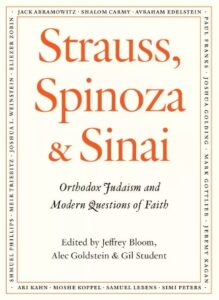 Leo Strauss (1899-1973) was a renowned political philosopher at the University of Chicago. To Orthodox Jews, he is probably best known for one slice of his large legacy, namely, his discomfiting portrayal of Maimonides as the holder of radical, untraditional beliefs. Strauss’s methods of studying Rambam do not enjoy the academic allegiance they once did. This book, however, invests Strauss with new relevance for TRADITION’s readers. It rests on an improbable, out-of-the-box, but ultimately fruitful idea: that a short passage Strauss authored in his preface to an English edition of his Spinoza’s Critique of Religion could serve as a focus for a vital discussion of Orthodoxy—one that would elicit responses from seventeen Orthodox thinkers.
Leo Strauss (1899-1973) was a renowned political philosopher at the University of Chicago. To Orthodox Jews, he is probably best known for one slice of his large legacy, namely, his discomfiting portrayal of Maimonides as the holder of radical, untraditional beliefs. Strauss’s methods of studying Rambam do not enjoy the academic allegiance they once did. This book, however, invests Strauss with new relevance for TRADITION’s readers. It rests on an improbable, out-of-the-box, but ultimately fruitful idea: that a short passage Strauss authored in his preface to an English edition of his Spinoza’s Critique of Religion could serve as a focus for a vital discussion of Orthodoxy—one that would elicit responses from seventeen Orthodox thinkers.
Strauss was not Orthodox, but in that preface, he offered a partial defense of Orthodoxy. I say “partial” because Orthodox Jews will find the defense incomplete and unsatisfying—as the book’s contributions well illustrate. Strauss claimed that Spinoza has not refuted Orthodox claims that revelation and miracles occurred; those events may have happened. The traditional beliefs have not been disproved, nor can they be. The bad news is that they are not proven or provable either. Hence Orthodox Jews may have belief in revelation and miracles, but, Strauss claims, they do not possess knowledge.
Strauss, Spinoza & Sinai provides a diversified and often deep advocacy of Orthodoxy’s claim to religious knowledge. The authors strongly tend to agree that classical proofs of God’s existence are not the best route to such knowledge, and they present alternatives. Joshua Golding lays out and evaluates seven approaches. (Because Golding’s essay is a critical survey, it’s a good place to begin reading, though essays are alphabetically arranged.) Several authors, such as Shalom Carmy, Paul Franks, and Alec Goldstein, conceive knowledge (in Judaism) on the model of a personal encounter or relationship. Samuel Lebens combines a Jewish version of Pascal’s wager (he calls it Pascalberg’s wager) with an endorsement of a mystical path to knowledge and an argument that the bases for biblical criticism are question-begging. Other authors appeal to morality (Moshe Koppel), intuition (Jeremy Kagan), meaning (Eliezer Zobin) or personal acquaintance with sages (Gil Student). Several essays feature the Oral Law (e.g., Joshua Weinstein). Simi Peters cites the tenacity of Jewish belief across history as evidence of its truth. Some essays (like Ari Kahn’s) either reject the distinction between belief and knowledge or invert Strauss’s assumed hierarchy. Mark Gottlieb provides an extensive account of Strauss’s thought and applies it to contemporary halakhic issues. The editors close the book with a keen analysis of the responses. The essays differ interestingly in the sources they marshal and how much attention they devote to related works by Strauss. (Unfortunately, I can’t cite all the essays, but see the table of contents.)
It’s all good, meaningful reading, and highly recommended. Readers should consider complementing this book with The Revelation at Sinai: What Does “Torah From Heaven” Mean?, edited by Yoram Hazony, Gil Student and Alex Sztuden (Ktav).
Yuval Levin, A Time to Build: From Family and Community to Congress and the Campus, How Recommitting to Our Institutions Can Revive the American Dream (Basic Books)
Chaim Strauchler
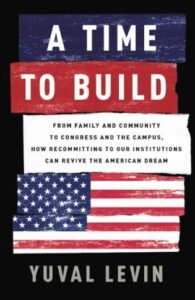 A political call-to-arms is not a typical summer read, but A Time to Build’s vision of social recovery can generate warmth during a not-so-summery political season. Yuval Levin follows in Tocqueville’s footsteps seeing in social organization the critical ingredient to a nation’s well-being. However, for Levin these institutions are not just voluntary associations but institutions more broadly understood, including Congress, the mainstream press, universities, corporations, the family, religion, the military and even the rule of law. For the readers of TRADITION who spends so much time nurturing institutions, whether as volunteers or professionals, Levin’s story should be especially empowering and inspiring.
A political call-to-arms is not a typical summer read, but A Time to Build’s vision of social recovery can generate warmth during a not-so-summery political season. Yuval Levin follows in Tocqueville’s footsteps seeing in social organization the critical ingredient to a nation’s well-being. However, for Levin these institutions are not just voluntary associations but institutions more broadly understood, including Congress, the mainstream press, universities, corporations, the family, religion, the military and even the rule of law. For the readers of TRADITION who spends so much time nurturing institutions, whether as volunteers or professionals, Levin’s story should be especially empowering and inspiring.
Levin argues that to heal our broken society we must recommit to our institutions. At a time of growing political polarization, alienation and despair, Levin’s prescription strikes a hopeful tone. Levin claims that populist anger (on the right and left) directed at our institutions is ultimately counterproductive. It was not the institutions’ oppressive presence but rather their debilitating absence that created our current political crisis. We need social organizations to unite us and to guard against our growing alienation.
In describing the collapse of institutional life, Levin distinguishes between previous generations who poured themselves into institutional molds, which formed their characters, and the institutions of today, which many use as platforms for self-expression and personal advancement. “By giving shape to our experience of life in society,” he writes, “institutions give shape to our place in the world.” Levin claims we need institutions to once again mold us. The cultural clichés of breaking free from institutional constraints ignores our need for structure and belonging. We desperately require institutions for these critical parts of our identity.
In assuming positions within a well-defined institution with culture, “we must all accept the responsibilities that come with the positions we hold, and we must ensure that obligations and restraints actually protect and empower us. We need to inhabit these institutions, love them, and reform them to help make them more lovely to others as well.” In calling us to build such relationships with formative institutions, Levin describes “a kind of devotion, even submission, to institutional formation” familiar to our understanding of family and religious community. He speaks a language that we understand better than most. It is a language that we might model for other Americans – so that they might benefit from it too.
Adele Reinhartz, Why Ask My Name? Anonymity and Identity in Biblical Narrative (Oxford University Press)
Sarah Rudolph
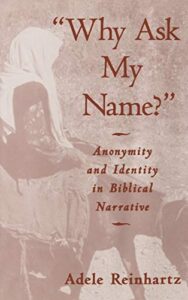 As it happens, I was introduced to Adele Reinhartz and her book, Why Ask My Name?, by a basically anonymous source. I had posted in a Facebook group about a class on unnamed women in Tanakh that I was preparing, and someone recommended this book. I must have seen the person’s name at the time, but quickly forgot it; it wasn’t anybody I knew. And thus, a very real example of the significant roles that can be played by anonymous “characters” in our lives, as well as in our stories.
As it happens, I was introduced to Adele Reinhartz and her book, Why Ask My Name?, by a basically anonymous source. I had posted in a Facebook group about a class on unnamed women in Tanakh that I was preparing, and someone recommended this book. I must have seen the person’s name at the time, but quickly forgot it; it wasn’t anybody I knew. And thus, a very real example of the significant roles that can be played by anonymous “characters” in our lives, as well as in our stories.
Reinhartz opens the book by sharing how she had first become interested in the topic, including some of her preconceived ideas that were proved untrue. “Where I had expected only a small number of unnamed characters, I discovered more than a hundred… Where I had anticipated a preponderance of women, I found abundant men, children and angels, as well as a talking animal or two. Whereas I had associated anonymity with indistinctness, personality, and distance, I was soon absorbed with these characters.” Her discoveries matched my own thoughts about the women I was planning to teach about, and the acknowledgment of how her views had changed drew me in to discover just how she had developed her own thoughts about these women and others – including the men, children, and animals.
While biblical scholarship can sometimes be fairly dense, I found this book as a whole to be a surprisingly light and engaging – but still informative – read. Reinhartz brings in literary theory as well as other academic disciplines, but she does so with clarity and, for the most part, an excellent balance of expertise and accessibility. Her attention to detail also gives expression to truths about human existence that we tend not to notice – such as the ways in which we are impacted by anonymous individuals on a daily basis (like the barista who sold me the coffee powering this day of writing), how we do and don’t think about them, and how that can shed light on how we interact with characters we read about in Tanakh or in any book.
One of the most enjoyable aspects of the book is in simple storytelling, and the promise of greater depth that follows on that introduction. Reinhartz tells the stories of many anonymous characters I had never really noticed (she has a whole chapter on “The Bit Players”), as well as many of the better-known examples (such as Manoah’s wife, whose surprising anonymity started Reinhartz on the topic). Though some of her assumptions and conclusions don’t quite mesh with my own views, Reinhartz’s summaries and insights bring individuals’ existence to light and their personalities to life. Reading the book, one cannot help but share her absorption with “these characters, whose personalities and stories became vital, vibrant, and vivid to me.” And once we meet and begin to get to know them, the possibilities for our own insights are endless.
Salo Baron: The Past and Future of Jewish Studies in America, edited by Rebecca Kobrin (Columbia University Press)
Lawrence Kobrin
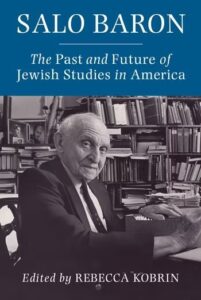 I begin with the full disclosure: the editor of this interesting volume is my daughter, Rebecca Kobrin, Professor of American Jewish History at Columbia University. The interesting collection of essays stands on its own nevertheless. They serve to remind us of the long and often difficult struggle to bring serious academic study of Jewish history into the mainstream of American universities. This is a welcome reminder at a time when some are questioning the role of Jews and Jewish studies in the framework of the secular university system.
I begin with the full disclosure: the editor of this interesting volume is my daughter, Rebecca Kobrin, Professor of American Jewish History at Columbia University. The interesting collection of essays stands on its own nevertheless. They serve to remind us of the long and often difficult struggle to bring serious academic study of Jewish history into the mainstream of American universities. This is a welcome reminder at a time when some are questioning the role of Jews and Jewish studies in the framework of the secular university system.
Salo Wittmayer Baron (1895-1989), was widely considered the greatest American Jewish historian of the twentieth century, having spent a decades-long career at Columbia. By incorporating Jewish religious life as an area of scholarly focus his monumental, 18-volume A Social and Religious History of the Jews served as an important corrective to many of works of Jewish history that preceded it. The current collection was originally conceived to be the result of a conference devoted to the Baron’s career and impact. When the pandemic thwarted any in-person meeting, the essays were brought together in this volume. The compilation under lockdown conditions was a feat in itself (if I do say so), but each of the essays serves as an important reminder of the sometimes arduous course of acceptance of Jewish studies into the academic world in America and elsewhere. Each of the dozen or so authors brings a different point of view to the description. These include the study of the impact of emancipation, economic aspects of Jewish history research, and the ongoing survival of anti-Semitism.
Baron may be most widely remembered for his criticism of the “lachrymose” theory of Jewish history but in creating the field of study he made other equally important and often revolutionary marks. The academic political maneuvering by which the chair at Columbia was established and he was invited to be its first occupant is an interesting window into a somewhat forgotten chapter in New York Jewish history. Baron’s appearance at the Eichmann trial as an historical expert was an interesting footnote to that seminal event and is described in detail by Deborah Lipstadt, someone who knows about courtroom treatment of the
Holocaust. The editor has some trenchant summarizing points and the book concludes with a comprehensive bibliography assembled by the intrepid Menachem Butler. Any one or more of the essays is worth the time.
The Autobiography of a Seventeenth-Century Venetian Rabbi: Leon Modena’s Life of Judah, translated and edited by Mark R. Cohen (Princeton University Press)
Yona Reiss
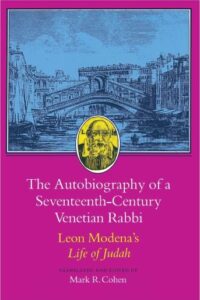 I took an interest in the life of Leon Modena (1571-1648) when I visited Venice in early 2020 on a Jewish Federation mission (immediately before Covid-19 relentlessly ravaged the region). Modena was a significant figure of the Venetian ghetto. Brilliant, worldly, and an accomplished Talmudic scholar, he attracted huge crowds of Jews and non-Jews alike who would flock to hear his erudite sermons. So great was his appeal amongst the gentiles that he was commissioned to write the first description of Jewish rituals written in the vernacular for a non-Jewish audience, the Riti, which became a major resource about Jewish religious life for the Christian community. Modena also developed a keen talent for music, and he played a major role in introducing musical melodies into the standard synagogue liturgy, including writing a groundbreaking responsum on this subject.
I took an interest in the life of Leon Modena (1571-1648) when I visited Venice in early 2020 on a Jewish Federation mission (immediately before Covid-19 relentlessly ravaged the region). Modena was a significant figure of the Venetian ghetto. Brilliant, worldly, and an accomplished Talmudic scholar, he attracted huge crowds of Jews and non-Jews alike who would flock to hear his erudite sermons. So great was his appeal amongst the gentiles that he was commissioned to write the first description of Jewish rituals written in the vernacular for a non-Jewish audience, the Riti, which became a major resource about Jewish religious life for the Christian community. Modena also developed a keen talent for music, and he played a major role in introducing musical melodies into the standard synagogue liturgy, including writing a groundbreaking responsum on this subject.
Modena lived a colorful and complex life, and remarkably chronicled much of it over the course of several decades in an incredibly candid autobiographical work, titled Hayyei Yehuda, now available in English translation, with helpful scholarly notes and accompanying essays highlighting his life and times, and elucidating the significance of this work in the rarefied genre of rabbinic autobiography.
The memoir describes certain triumphant moments, such as Modena’s ascendancy as a famed preacher in the ghetto, but also includes many heartbreaking events in his life, including the poignant death of the woman whom he was meant to marry, immediately before the wedding date in 1590, and, many years later, the horrifying gang murder in Venice of his son Zebulun in front of his own eyes. Modena writes wistfully about how he saw no joy from his three sons (another one died young, and the third was a ne’er-do-well) but at least took solace from the success of his students.
Perhaps the most intriguing aspect of the book is Modena’s willingness to share his own regrets and shortcomings, particularly in terms of his self-description as an inveterate gambler. However, since according to Jewish law, a person cannot render himself wicked through his testimony, there is considerable debate about the probity of judging Modena based on his own writings.
In this regard, it is noteworthy that R. Ovadia Yosef routinely cited Modena’s collection of rabbinic responsa, entitled Ziknei Yehuda, without disapproval or qualification. By contrast, R. Eliezer Yehuda Waldenberg devoted a lengthy excursus in his Tzitz Eliezer (13:12) to questioning Modena’s credentials as a halakhic authority, basing himself in large part upon Modena’s own admissions in the autobiography. At the same time, Modena himself writes, “my only prayer to [God] is that He should not take me away before I repent of my sins.” In reading this book, and coming to appreciate both his heartbreak and humanity, I could not help but want to give Modena the benefit of the doubt.
Yakov Nagen, Mayim, Beri’a ve-Hitgalut: Hag ha-Sukkot be-Mahashevet ha-Halakha (Yeshivat Otniel)
Isaac Selter, Editorial Assistant
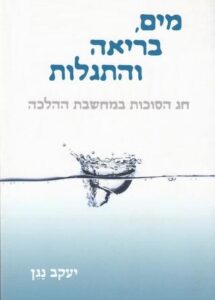 The laws of Sukkot abound, and many, including this writer, find it overwhelming to properly prepare for Sukkot—both in a technical-halakhic sense (e.g., reviewing the laws of a Sukka’s dimensions or preparing lulav-ties that will maximize the shake-ability/durability ratio of my four species) and in a spiritual/emotional sense (e.g., what exactly am I supposed to have in mind while encircling the bima with my lulav, while doing my best to not spear my neighbor in the neck?). Yakov Nagen’s Hebrew volume Mayim, Beri’a ve-Hitgalut, bridges these two worlds and provides a consistent, coherent, and compelling overview of the holiday and its themes.
The laws of Sukkot abound, and many, including this writer, find it overwhelming to properly prepare for Sukkot—both in a technical-halakhic sense (e.g., reviewing the laws of a Sukka’s dimensions or preparing lulav-ties that will maximize the shake-ability/durability ratio of my four species) and in a spiritual/emotional sense (e.g., what exactly am I supposed to have in mind while encircling the bima with my lulav, while doing my best to not spear my neighbor in the neck?). Yakov Nagen’s Hebrew volume Mayim, Beri’a ve-Hitgalut, bridges these two worlds and provides a consistent, coherent, and compelling overview of the holiday and its themes.
While our usual ‘’go-to’’ for finding meaning in Judaism is to peruse aggadic sources, Nagen, following the Kookian vision of ideal Torah learning (see, e.g., Orot ha-Torah 2, 3), insists on seeking the values that underlie the minutiae of halakha and uses them to clarify the central spiritual themes of the holiday. Nagen, of course, does not ignore aggadic sources; he calls upon midreshei aggada, Zohar, Sefer Yetzira, Sefer ha-Bahir, and more to bolster his theses, while striving to answer Rav Kook’s call, “to pave paths in our learning through which halakha and aggada will be essentially connected.” Moreover, the presentation and structure of mishnayot and toseftot, the shakla ve-tarya of the Gemara, and analysis of Rishonim with some sprinkles of classical lomdus, all contribute to Nagen’s construction of what he argues are the main motifs of Sukkot.
Staying true to his modus operandi, “Spirituality Needs Scholarship,” Nagen also makes use of academic scholarship as well as manuscript analysis to illustrate the beauty of the Torah’s wisdom and to facilitate the emergence of a clear path for personal religious meaning within the daled amot of halakha. For example, academic research on ancient religious practice makes frequent appearances in these pages and helps Nagen conceptually frame his assertions, while alternate versions of a familiar Gemara provide subtle hints at profound ideas.
Is it accidental that the measurements of the sukka are expounded from the measurements of aron kodesh? Why are the ‘’blemishes’’ of four species so similar to those of korbanot? Why are echoes of King David and Solomon found in the Tosefta’s presentation of Simhat Beit ha-Sho’eva? The answers and more can be found in this remarkable work. Prepare for Sukkot properly and pick up this book.
Carl R. Trueman, The Rise and Triumph of the Modern Self: Cultural Amnesia, Expressive Individualism, and the Road to Sexual Revolution (Crossway)
Mark Gottlieb
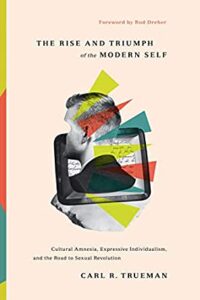 Starting with Alasdair MacIntyre’s monumental triumph of modern moral theory, After Virtue (1981), a steady stream of historical, cultural, and philosophical broadsides have appeared, variously diagnosing the pathologies of our late liberal West. Radical individualism, emotivism, “Bowling Alone,” the Protestant Reformation, the Sexual Revolution, the death of God and loss of religion, and even Locke’s procedural Liberalism itself—once the proud standard-bearer and source of American democracy, or so I learned in high school—are all put in the docket, made to answer for their cultural crimes of omission or commission. And while generally sharing the sense of crisis these books are designed to evoke, it’s hard to dispute that some of the entries to this newly popular genre are, naturally, better than others; if the barometer for excellence is subtlety of analysis, originality of claims, and trenchant relevance to current realities, then only a handful of these books emerge as truly noteworthy. Carl Trueman’s ambitious but carefully argued The Rise of Triumph of the Modern Self makes a signal contribution to this literature of cultural crisis, one that Modern Orthodox Jews must read with open eyes, hearts, and minds.
Starting with Alasdair MacIntyre’s monumental triumph of modern moral theory, After Virtue (1981), a steady stream of historical, cultural, and philosophical broadsides have appeared, variously diagnosing the pathologies of our late liberal West. Radical individualism, emotivism, “Bowling Alone,” the Protestant Reformation, the Sexual Revolution, the death of God and loss of religion, and even Locke’s procedural Liberalism itself—once the proud standard-bearer and source of American democracy, or so I learned in high school—are all put in the docket, made to answer for their cultural crimes of omission or commission. And while generally sharing the sense of crisis these books are designed to evoke, it’s hard to dispute that some of the entries to this newly popular genre are, naturally, better than others; if the barometer for excellence is subtlety of analysis, originality of claims, and trenchant relevance to current realities, then only a handful of these books emerge as truly noteworthy. Carl Trueman’s ambitious but carefully argued The Rise of Triumph of the Modern Self makes a signal contribution to this literature of cultural crisis, one that Modern Orthodox Jews must read with open eyes, hearts, and minds.
While borrowing some basic tropes from contemporary critics of modernity like MacIntyre, Charles Taylor, Philip Rieff, and Augusto del Noce, Trueman’s real contribution is his genealogy of foundational modern thinkers from Rousseau and Mary Wollstonecraft to Nietzsche, Marx, Marcuse, and Foucault, and the relevance of their teachings to recent cultural and legal developments in redefining sexuality, marriage, transgenderism, and identity. What the average American considered normative when it came to the nature of marriage or gender is simply no longer. The speed with which these transformations have taken place— even Barack Obama, no cultural reactionary, did not unequivocally support gay marriage until 2012—pushes the careful thinker to search for deeper, more elemental causes than surface phenomena or our current political polarization can account for.
What sets Trueman’s treatment apart from similar but less compelling efforts is the non-hyperbolic nature of his analysis. He knows that the kind of work he is engaged in often overreaches, blurring the lines between scholarship and advocacy. He attempts both with refreshing honesty, giving each its due: “I want to help the reader see that the debates about sexuality that increasingly dominate our public square need to be set in a much broader and deeper context than we typically acknowledge—and that all of us are to some extent implicated.” Perhaps most powerfully, Trueman confesses that his book “is not a lament for a lost golden age or even for the parlous state of culture as we now face it.” What’s needed now is not lamentation but clarity, the clarity to see things as they now are through the prism of our tradition towards an authentic theological anthropology, a Torah philosophy of the human person. Of course, we need compassion, too. But clarity first. And in these fraught, tense times, clarity with a generous dose of Trueman’s honesty and humility may go a long way.
Read the first installment of this year’s list and peruse previous lists of TRADITION’s Summer Book Endorsements for 2020 & 2021.


1 Comment
[…] R’ David Bashevkin has created a whole following on Twitter discussing books weekly. In his podcast series he has given this month to devote to talking about different aspects related to books. Nachi Weinstein at Seforim Chatter is still going strong between book listings and podcasts, and Tradition has released their Summer recommended reading lists (here and here). […]